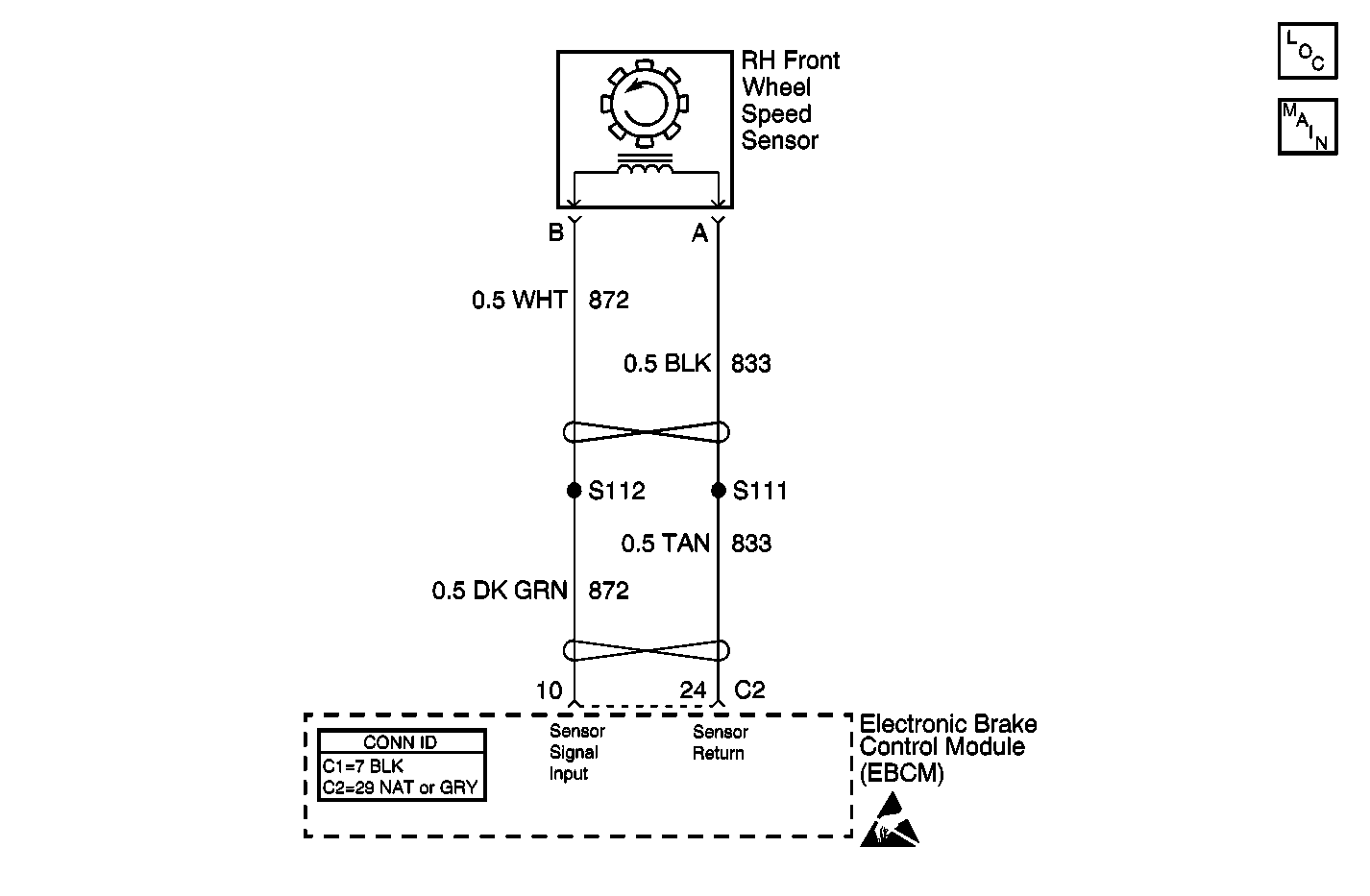
Circuit Description
As the wheel spins, the wheel speed sensor produces an AC signal. The electronic brake control module (EBCM) uses the frequency of the AC signal to calculate the wheel speed.
Conditions for Running the DTC
| • | DTCs C1232-C1235 are not set. |
| • | The brake pedal is not pressed. |
| • | The ABS is not active. |
Conditions for Setting the DTC
All of the following conditions exists for 2.5 seconds:
| • | The suspect wheel speed equals zero. |
| • | The other wheel speeds are greater than 8 km/h (5 mph). |
| • | The other wheel speeds are within 11 km/h (7 mph) of each other. |
Action Taken When the DTC Sets
If equipped, the following actions occur:
| • | The EBCM disables the ABS/TCS/VSES for the duration of the ignition cycle. |
| • | The EBCM temporarily suspends the TIM monitoring function while the DTC is set. |
| • | The DRP does not function optimally. |
| • | The ABS indicator turns ON. |
| • | The TRAC OFF indicator turns ON. |
| • | The DIC displays the SERVICE STABILITY SYSTEM message. |
Conditions for Clearing the DTC
| • | The condition for the DTC is no longer present and the DTC is cleared with a scan tool. |
| • | The electronic brake control module (EBCM) automatically clears the history DTC when a current DTC is not detected in 100 consecutive drive cycles. |
Diagnostic Aids
Under the following conditions, 2 Wheel Speed Sensor Input is 0 DTCs are set:
| • | The 2 suspect wheel speeds equal zero for 60 seconds. |
| • | The other wheel speeds are greater than 16 km/h (10 mph). |
| • | The other wheel speeds are within 11 km/h (7 mph) of each other. |
Diagnose each wheel speed sensor individually.
Test Description
The numbers below refer to the step numbers on the diagnostic table.
-
This step measures the resistance of the wheel speed sensor.
-
This step tests whether the wheel speed sensor circuits are shorted together.
Step | Action | Value(s) | Yes | No | ||||||
|---|---|---|---|---|---|---|---|---|---|---|
1 | Did you perform the ABS Diagnostic System Check? | -- | Go to Step 2 | |||||||
2 |
Does the scan tool indicate the suspect wheel varies from the speeds of the other wheels? | -- | Go to Step 3 | Go to Diagnostic Aids | ||||||
Does the resistance measure within the specified range? | 850-1350 ohms | Go to Step 4 | Go to Step 8 | |||||||
4 |
Does the AC voltage measure greater than the specified value? | 100 mV | Go to Step 5 | Go to Step 8 | ||||||
5 | Inspect for poor connections at the harness connector of the wheel speed sensor. Refer to Testing for Intermittent Conditions and Poor Connections and Connector Repairs in Wiring Systems. Did you find and correct the condition? | -- | Go to Step 10 | Go to Step 6 | ||||||
Important: If equipped with TIM, removing battery voltage or ground from the EBCM
will result in the following conditions.
Did you find and correct the condition? | -- | Go to Step 10 | Go to Step 7 | |||||||
7 | Inspect for poor connections at the harness connector of the EBCM. Refer to Testing for Intermittent Conditions and Poor Connections and Connector Repairs in Wiring Systems. Did you find and correct the condition? | -- | Go to Step 10 | Go to Step 9 | ||||||
8 | Replace the wheel speed sensor. Refer to Wheel Speed Sensor Replacement . Did you complete the repair? | -- | Go to Step 10 | -- | ||||||
9 |
Important: Perform the setup procedure for the EBCM. An unprogrammed EBCM will
result in the following conditions:
Replace the EBCM. Refer to Electronic Brake Control Module Replacement . Did you complete the repair? | -- | Go to Step 10 | -- | ||||||
10 |
Does the DTC reset? | -- | Go to Step 2 | System OK |
